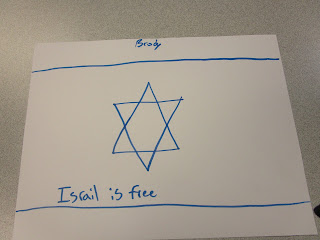 |
| As soon as we entered the Museum, Ruth brought our attention to the many globes hanging overhead, representing the fact that Jews have lived all over the world for at least two millenia. She also shared that there are Hebrew letters incorporated into the walls at various sites in the Museum - in the hallway she pointed out the letters "Pey" "Resh" Daled" and "Samech" which form the acronym "PARDES." The Hebrew word "pardes" itself is borrowed from old Persian and means "orchard." We get our English word "paradise" from pardes. |
 |
| As we rounded the corner from the entrance hallway, we came upon a curious machine. What a wonderful introduction to the Rube Goldberg exhibit we had come to view. |
Later on, after we had viewed the exhibit and were on our way to another exhibit upstairs, Ruth gave the students time to try out the machine themselves. They were absolutely fascinated by how it worked!
 |
| The first part of the exhibit explored drawings that R.G. had made describing machines he invented to perform the simplest of chores. |
 |
| R.G. was a cartoonist, and one of his series of cartoons was called, "Foolish Questions." For each foolish question, he had a sarcastic response, as above. |
 |
| They all found "comfortable" places to write their responses. I read a few of their responses, but was sworn not to divulge them to anyone. |
 |
| As R.G. got older, it became difficult for him to draw multi-paneled cartoons. So he began to draw one-paneled political cartoons instead. The one above is from 1947. |
 |
| And I'm sure all the adults could empathize with the message above. |
 |
| Currently, there is an exhibit by an Israeli musician and composer named Kutiman in the Cube. |
 |
| Here's a Bella Feldman painting - look at all that red color (danger?). |
And here is a fascinating installation made by Ned Kohn:
The students had an interesting experience with a door that made an eerie sound when you opened it, and only later became aware of the fact that when the door was opened, it caused a panel on the wall next to it, to flip around:
 |
| At one point, we passed by the "ultimate machine" - the human body. |
And here's Tamara explaining it to her group:
For about 3/4 of an hour, the students and their parents and siblings became totally involved in designing Rube Goldberg-style machines out of everyday objects that they found on the tables as well as on tables at the back of the room. Below are sights and sounds of young minds and hands in the creative process, enjoying every minute.
Of course, there were frustrations along the way, but the students all persisted. As the saying goes, "If at first you don't succeed..."
"...try, try again!"
And parents also got involved!
Just before noon, it was time for the students in each group to learn if their individual projects which they had now connected on each table setting to the other projects, would go through all the steps they had devised for a "grand finale."
Here are Tamara's group's first steps:
And here is Ruth's group's "grand finale."
BRAVO TO ALL OUR JQUEST RUBE GOLDBERGS!
AND A VERY BIG THANK YOU TO OUR TWO DOCENTS, TAMARA AND RUTH WHO BROUGHT THE EXHIBITS TO LIFE FOR US. YASHER KOACH!










































